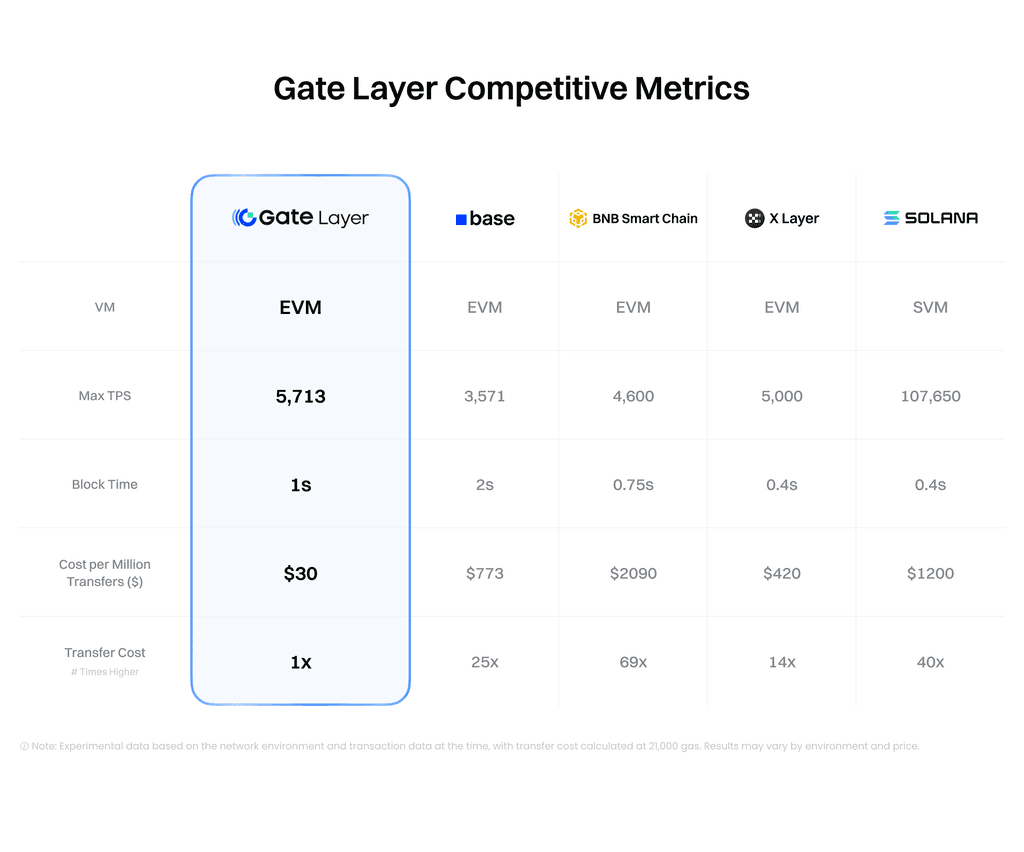Gate Layer Launch: High-Performance Layer 2 Network Driving Full GT Ecosystem Upgrade
Gate Layer Major Launch: Introducing a High-Performance Layer 2 Network

On September 25, 2025, Gate officially announced the release of Gate Layer, a high-performance Layer 2 network built on OP Stack, with Gate Chain as the main settlement layer. This launch targets longstanding blockchain challenges—including high gas fees and slow confirmations—and provides users and developers with a seamless, efficient, and cost-effective Web3 experience.
Gate Layer features full compatibility with the Ethereum Virtual Machine (EVM). Developers can migrate existing DApps without friction. Users can engage with the ecosystem using their familiar workflows. With up to 5,700 transactions per second and 1-second block intervals, Gate Layer enables true real-time on-chain interactions.
Core Technical Advantages: EVM Compatibility & Cross-Chain Interoperability
Gate Layer stands out with several key innovations:
- Full EVM compatibility—supporting the entire Ethereum toolchain (Remix, MetaMask, etc.) for effortless development and migration.
- Dual-layer security—leveraging Gate Chain’s settlement layer and GT staking to enhance network stability.
- Ultra-low gas fees—each million transactions costs only $30. This is significantly less than the fees on Base, BSC, or Solana.
- Cross-chain interoperability—integrating the LayerZero protocol for seamless asset transfers with major blockchains including ETH, BSC, and Polygon.
Gate Layer sets a new industry standard for performance and cost efficiency, making it ideal for deployment of large-scale applications.
Robust Ecosystem: Perp, Gate Fun, Meme Go
Powered by Gate Layer, Gate is rolling out a “three-pillar” ecosystem strategy to meet core Web3 user needs:
- Perp: A decentralized perpetual contract platform with liquidity rivaling top centralized exchanges.
- Gate Fun: A zero-code token launch and incubation platform, supporting emerging creators and meme initiatives in their early stages.
- Meme Go: A cross-chain meme coin monitoring and rapid trading hub, compatible with leading blockchains like ETH, BSC, and Solana.
Through these flagship products, Gate Layer supports users in asset creation, trading, and value realization.
GT Value Upgrade: Expanding Use Cases & Dual Deflation Mechanism
GT (GateToken), the cornerstone of Gate’s ecosystem, sees major upgrades in this release:
- Exclusive gas token—GT is required for all Gate Layer actions, including transactions, contract deployment, and NFT minting.
- Dual deflation mechanism—periodic token burning and on-chain destruction. By Q2 2025, over 180 million GT have been burned, representing more than 60% of total supply. As adoption grows, the supply decreases, increasing GT’s scarcity and value.
Gate Chain Advancement: Technical Enhancements & Security Upgrades
To support Gate Layer, Gate Chain has completed its v1.20 upgrade:
- Blob transaction support (EIP-4844)—dramatically improving efficiency;
- EVM upgrade to Cancun—supporting more complex contract needs;
- Compatibility with 12 EIP standards—further optimizing gas calculation and security;
- RPC interface improvements—delivering a streamlined experience for developers.
These enhancements deliver high-performance operations for Gate Layer and establish a robust foundation for future ecosystem growth.
For full details, read the announcement: https://www.gate.com/announcements/article/47349
Summary: Gate’s Strategic Leap Toward a Sustainable Web3 Ecosystem
The launch of Gate Layer marks a pivotal milestone in Gate’s mission to build an “efficient and inclusive Web3 ecosystem.” Gate is backed by high-performance Layer 2 technology, expanded GT utility and deflation mechanisms, and a comprehensive application matrix. This approach lays the groundwork for blockchain infrastructure that can support mass adoption.
As Gate Layer evolves, users, developers, and investors will benefit from the ecosystem upgrade. GT is positioned for continued long-term value growth.
Related Articles

Pi Coin Transaction Guide: How to Transfer to Gate.io

Flare Crypto Explained: What Is Flare Network and Why It Matters in 2025

How to Use a Crypto Whale Tracker: Top Tool Recommendation for 2025 to Follow Whale Moves

What is N2: An AI-Driven Layer 2 Solution

Understand Baby doge coin in one article
